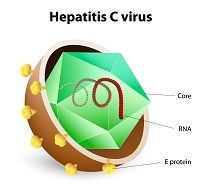Article
Using Viral Load to Predict Hepatitis C Cure Differs with New Drugs, Studies Suggest
Author(s):
Detectable hepatitis C viral loads seen when treatment has ended in patients taking direct acting antiviral therapy is not necessarily an indication that the drug regimen didn't work, according to results from a recent study.

Detectable hepatitis C viral loads seen when treatment has ended in patients taking direct acting antiviral therapy is not necessarily an indication that the drug regimen didn’t work, according to results from a recent study.
New direct acting antiviral (DAA) treatments for hepatitis C have begun to replace interferon-based treatments because the newer drugs typically have higher cure rates, take less time and have fewer serious side effects.
In traditional interferon-based treatment, hepatitis C viral loads were seen as predictors of how treatment was working and a mainstay of response-guided therapy, noted Sreetha Sidharthan of the National Institutes of Health, Bethesda, Maryland, and lead author of an article that appears in the journal Clinical Infectious Disease. Researchers set out to evaluate whether the hepatitis C virus (HCV) RNA levels of a patient who received interferon-free DAA therapies could be similarly predictive at the end of the treatment period for sustained virologic response at 12 weeks after treatment (SVR12).
Participants were enrolled in one of two clinical trials and included 114 patients with HCV genotype 1 who had never been treated for the disease. In one trial 55 patients took sofosbuvir with ribavirin for 24 weeks. In the other trial, 20 patients took sofosbuvir with ledipasvir for 12 weeks, 20 patients took sofosbuvir, ledipasvir and GS-9669 for 6 weeks and 19 took sofosbuvir, ledipasvir, and GS-9451 for 6 weeks.
During the studies, patient HCV viral load was measured using two tests - the Roche COBAS TaqMan HCV test and the Abbott RealTime HCV assay. Researchers calculated positive and negative predictive values of HCV RNA less than the level of quantification at end of treatment for SVR12.
Results indicated that the patients who were treated with sofosbuvir and ribavirin had HCV RNA levels that were less than the level of quantification at the end of treatment by both the Roche and Abbott test methods, however only 69% from that group (38 patients) obtained SVR12, according to the abstract. Among patients treated with either GS-9669 or GS-9451 and sofosbuvir and ledipasvir, 100% (59 out of 59 patients) by the Roche test and 90% (53 out of 59 patients) by the Abbott test had levels below quantification at the end of treatment (one patient relapsed).
The authors note that six patients who had detectable viral loads at the end of their treatment, later achieved SVR at 12 weeks post treatment. In addition, 2 weeks after treatment was completed, four patients had measurable HCV RNA levels and one patient had measurable levels at 4 weeks post-treatment.
Study authors concluded that contrary to past experience with interferon-containing treatments, the presence of detectable HCV RNA at the end of treatment does not preclude treatment success.
2 Commerce Drive
Cranbury, NJ 08512
All rights reserved.





